Module 14 - Lesson 1 - Planning for Success
Perhaps the most important part of working with a contractor is your communication before the work gets started. Whether the contractor is going to undertake to do silviculture, harvesting or road construction work, spending some time sitting at the kitchen table will enhance the contractor’s understanding of what you want. You will also gain knowledge of the contractor’s capacity for doing the work.
First, you should review your woodland stewardship plan. This document lays the foundation for all the work on your property, and should be a logical starting point for any discussion with a contractor. Show the contractor the map or aerial photo of your woodland, and mark the proposed work area clearly. You should provide the contractor with a copy of the map and outlined area.
If you have differences of opinion regarding where the work should be done, or at what rate, it may be prudent to visit the site on the ground and discuss the details. A forest professional can act on your behalf if you cannot visit the site personally. If a site is to be marked with flagging tape before the work begins, a forest professional can do this too.
 |
| Planning work on the ground includes flagging trees and sites that may have special significance. |
It is at the planning stage that you should make any special wishes known to the contractor. Perhaps you would like certain trees or areas of trees left standing. If some areas of the work site are significant to you – such as the presence of old structure foundations or even a small family cemetery – make your concerns known to the contractor.
Planning for Safety
You should also inform the contractor of any hazards which may be present on the property, such as old wells, garbage dumps, and road gates and cables. You should mark these potential hazards clearly with flagging tape or bright paint. Warning signs can also be used to alert workers and other individuals of potentially unsafe areas on your property. Reducing the likelihood of injury and limiting your liability risk is paramount in getting the job completed satisfactorily.
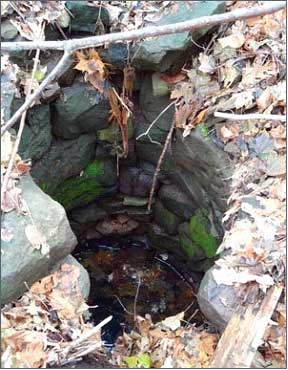 |
| Old wells, if unmarked, may present hazards to contractors and the general public. |
What Kind of Contractor Do You Need?
First, study your stewardship plan
Your woodland stewardship plan should have a detailed list of work to be carried out on your woodland over the next several years. If you do not have a stewardship plan, refer to Module 1A. The woodland plan map should identify the kinds of work that can be done in areas of your property.
If you need confirmation of whether a particular treatment is suitable, it is a good idea to contact a forest professional, who can carry out a pre-treatment assessment (PTA) and verify your work plans. These individuals are trained to recognize and recommend forest improvement work. Some work, such as harvesting and commercial thinning – because they require the extraction of wood products - may require suitable ground conditions and may be seasonal. For this reason it is good to ascertain whether timing is an issue.
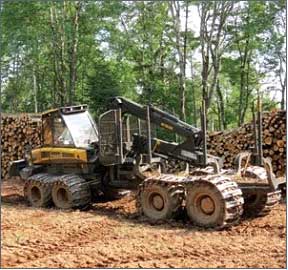 |
| The extraction of wood may be limited to certain seasons when using heavy equipment. |
Other forestry work that does not require the use of heavy equipment may not have the same seasonal restrictions. These include:
Pre-commercial thinning (PCT);
Tree planting (best done in the spring or fall);
Early competition control (sometimes called manual weeding); and
Boundary line maintenance.
For most of these treatments there may be opportunities to receive financial assistance. Refer to the Additional Resources near the back of this module for further information.
Gaining access: road construction contractors
You may first need to consider the services of a road construction contractor should you require a new road or if an existing road is to be upgraded to access your woodland. Road contractors usually employ excavators and bulldozers to carry out their work. It is important to remember most roads need time to “set up” after construction. It may take several months for a road to drain and dry out sufficiently to enable logging trucks to travel on its surface. Keep this in mind when you are talking with a harvesting contractor, since an expensive road can be ruined in a short time.
Ensure your road construction contractor has access to maps of your woodland so he can clearly see the layout of your property, and where the road must be located to access areas of forestry work. Keep in mind a shorter road may not mean a cheaper road. The installation of culverts and watercourse crossings may greatly increase the cost of your road.
The centerline of the road should be flagged to indicate the route that will be taken. If a road right- of-way must be cut, the sidelines should be flagged so that the opening for the road is neither too narrow nor too wide. A width of 15 to 20 meters will ensure the roadbed receives full sunlight, which should dry the road surface and allow earlier access each spring. A forest professional who is familiar with your woodland is often the best choice to lay out the road location and dimensions. Refer to Module 11 for further information on road construction.
 |
|
| A well-built road is a key component of successful woodland stewardship. | |
You may first require a harvesting contractor to cut the road right-of-way for the road contractor. Make sure the width of the right-of-way is cut no wider than the sideline flagging, unless you have prior agreement with the harvesting contractor on this issue. If the wood is piled within the right-of-way it should be located so it is not in the way of road construction and, once the road is built, a logging truck will have no problems reaching it. A forest professional can help supervise the harvesting of the right-of-way and the construction of the road.
Building a road across a watercourse, or crossing a watercourse with heavy equipment requires a permit from Nova Scotia Department of Environment. Permits are usually issued only to individuals who have received watercourse alteration training, and are certified. A number of forest professionals and road construction contractors possess this certification. Contact the Department of Environment for a list of certified individuals. For more information on road construction see Lesson 2 of this module.
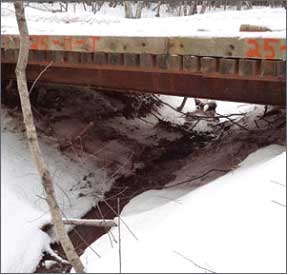 |
| Proper temporary crossings are mandatory for wood forwarding and trucking. |
Finding the Right Contractor
Once you have decided which type of work you wish to do on your woodland, how do you find the right contractor for the job? Perhaps the best and most frequently used search method is by word-of-mouth. Woodland owners who have successfully used contractors with good results are not hesitant about recommending them to other woodland owners.
Talk with your neighbours
Get to know some active woodland owners in your area and you will find a wealth of information about more than just contractors. Other woodland owners - particularly those who work extensively on their own properties - can tell you about forest products market conditions, which mill is paying the best rates, and ways in which they have successfully tackled problems on their own properties. They may share their knowledge about local wildlife, where to get funding assistance and even how to properly sharpen a chainsaw. Get to know some fellow woodland owners – you’ll be glad you did!
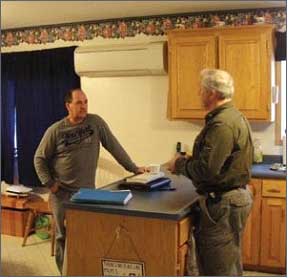 |
|
Your neighbours may be able to recommend good woodland contactors. |
Do your research
Contractors are business-people, and many of them advertise their services. Sometimes your local daily or weekly paper will have ads placed by woodland contractors looking for a continuous supply of work. Contractors may also advertise online, including
on the Forest Service Directory (www.FSDB.com). This useful website lists contractors by service type. The site also lists forest professionals who wish to advertise their services. Check it out!
Have reasonable expectations
At some point you may wish to ask yourself, “What is most important about my woodland – the quality of the work, or a high stumpage payment?” Often there must be trade-offs. Remember contractors have a business to run. If you encounter a contractor who appears to make big promises, you should get those pledges in writing, and perhaps add them to your job contract.
It can be difficult to find exactly the right woodland contractor that meets your every need. You, as the landowner, must be reasonable in your expectations. Does a stumpage rate sound too low? Ask around, get some quotes from other contractors, and you might be surprised at the variety of responses you receive. Do you want to harvest every last tree on your property for maximum income? Read the provincial Wildlife Habitat and Watercourse Regulations and you may find that this is impossible.
The adage “If it sounds too good to be true, it probably is,” holds true in many circumstances, including woodland management.
If you have high expectations and you cannot find a contractor that meets your needs, it may be time
to become a contractor yourself. You could find that controlling costs while undertaking the perfect job can be challenging, particularly if you invest in expensive equipment.
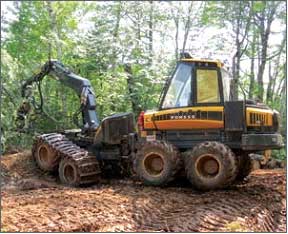 |
| It is important to determine whether your potential contractor has the proper equipment for the job. |
Evaluate Your
Getting Involved
As a woodland owner, how involved should you be with a contractor and their job? Are you a landowner who prefers to work closely with a contractor, perhaps even doing some of the work yourself? If so, it is important to confirm the contractor is okay with your participation.
Most contractors have their own unique approach to completing a job and although some may welcome your involvement, others may not. Silviculture contractors are aware of the criteria and standards for silviculture and want to ensure the standards are met. Unless you are familiar with these standards, and the type of equipment needed to complete the job, it is difficult to work with a woodland contractor to their satisfaction.
It is usually better to stay at arm’s-length to a contractor and frequently monitor his or her activity to ensure that the standards of your contract are being met. They know how to do the work best. Let them do so.
 |
| Contractors and machine operators are knowledgeable and are usually willing to discuss woodland management options. |
Being Your Own Contractor
Some woodland owners, if they have the time and experience, decide to carry out their own work as the contractor. These folks are often called owner-operators.
By hiring your own workers you can often get work done at less expense, but experience and an investment in specialized equipment may be necessary if you wish to follow this path. Ultimately, you will be responsible for the quality of the job, keeping your workers motivated and carrying the proper insurance. If it is a harvesting job, you may also be responsible for forwarding wood to roadside, making arrangements for trucking, and ensuring that mill specifications on the wood are met. For any kind of work you must be accountable for worker safety and job quality standards.
Does this sound like a tall order? It can be, and woodland owners are often surprised by the intensive nature of being their own contractor and the attention to detail that it requires. It’s not for everyone, but it could be for you!
Are You an Absentee Woodland Owner?
Living hundreds or thousands of kilometers from your woodland can make it challenging to manage your woodland properly. It may be impossible to meet with contractors face-to-face.
Through emails and teleconferencing, absentee landowners can learn about the progress of work on their woodlands in real-time. Photos and videos of work being done can provide some assurance that many details of a contract are being met. Such electronic communication is common practice amongst most woodland contractors and forest professionals, but this too should be included in a contract.
Forest professionals can reduce much of the guesswork and uncertainty that go hand-in-hand with being an absentee woodland owner. A professional can arrange the details of harvesting and silviculture contracts, supervise work and generally look after your woodland management interests in your absence.
 |
| Hiring a forest professional is often a good choice for absentee woodland owners. |